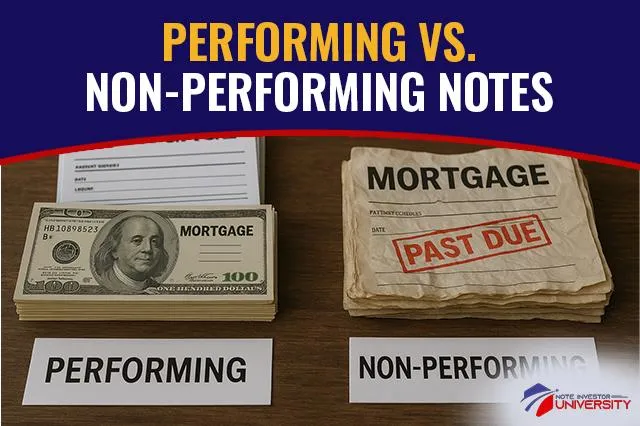
Performing vs. Non-Performing Notes: What Every Investor Needs to Know
If you're exploring mortgage note investing in 2025, you'll quickly come across two key terms: performing notes and non-performing notes.
While both types of notes can generate income and build wealth, they come with very different risk profiles, strategies, and returns. Understanding the difference is critical to making smart investment decisions.
In this blog, we’ll break down how each type works, which one is better for beginners, and how to decide which fits your investing goals.
What Is a Performing Note?
A performing note is a loan where the borrower is making regular, on-time payments as agreed in the promissory note.
When you buy a performing note:
You receive monthly principal and interest payments.
The borrower stays in the property and maintains it.
Your cash flow is stable and predictable.
This is the most popular entry point for new note investors because it offers passive income with lower risk and less involvement.
What Is a Non-Performing Note?
A non-performing note is a loan where the borrower has missed payments, typically 90 days or more. These notes are often sold at a discount because the cash flow is either delayed or nonexistent.
However, the investor has options, including:
Modifying the loan terms
Offering a deed-in-lieu of foreclosure
Initiating foreclosure and acquiring the property
This strategy can lead to high returns, but it requires more time, legal knowledge, and a clear workout plan.
Key Differences Between Performing and Non-Performing Notes
Cash Flow:
Performing notes generate immediate income.
Non-performing notes may take months before they produce cash flow.
Risk:
Performing notes are more predictable and lower risk.
Non-performing notes offer higher upside but greater uncertainty.
Management:
Performing notes are typically managed by a loan servicer.
Non-performing notes often require active involvement in loss mitigation or legal action.
Investment Goal:
Performing is ideal for cash flow.
Non-performing is better suited for discounted acquisition or property ownership.
Which One Should You Start With?
If you’re new to note investing, start with performing notes. They allow you to:
Understand the buying process
Work with a loan servicer
Receive regular income
Gain confidence in the model
Once you’re familiar with the fundamentals, you can explore non-performing notes with a higher return potential and more complex strategies.
Want to see real-life examples of both?
Watch our 10-part video training series on note investing to see the full investment lifecycle—from performing cash flow to non-performing workouts.
Case Study: Comparing the Two
Imagine two $50,000 notes:
Note A is performing, pays $500 per month, and has 10 years remaining. That’s $6,000 a year in income, roughly a 12% return.
Note B is non-performing, has the same balance, but is offered at $25,000. After legal work and a loan mod, it could re-perform or result in a property worth $60,000.
While Note B might yield a higher return, it involves more time, uncertainty, and execution risk.
Final Thoughts
Performing and non-performing notes both offer unique benefits. Your choice should depend on your experience, risk tolerance, and income goals.
Start with performing notes to learn the basics, then graduate to non-performing strategies once you have a strong foundation.
If you're ready to begin your journey, we've made it easy for you to take the first step.
Learn the basics with our $1 Starter Pack
Get the system, checklists, and training to buy your first performing note and start collecting monthly cash flow.
Or, if you're ready to learn how to restructure or manage non-performing notes,
Apply for our Mentorship Program and get guided help from industry veterans.